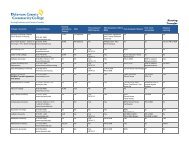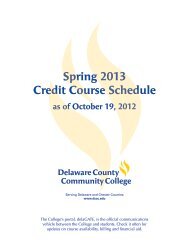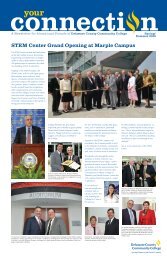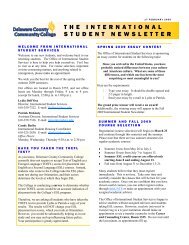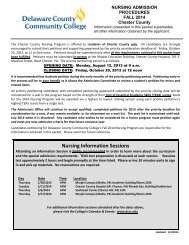2010 Catalog - Delaware County Community College
2010 Catalog - Delaware County Community College
2010 Catalog - Delaware County Community College
You also want an ePaper? Increase the reach of your titles
YUMPU automatically turns print PDFs into web optimized ePapers that Google loves.
168 COURSE DESCRIPTIONS<br />
turning operations.<br />
• Apply appropriate techniques for modeling mill/turn<br />
operations and for creating machine tool code.<br />
• Plan, develop, edit and execute macros for family- ofparts<br />
operations.<br />
Prereq. TME 212<br />
3 Credits 2 Weekly Lecture Hours<br />
2 Weekly Laboratory Hours<br />
TME 229<br />
Fluid Power and Controls<br />
This course provides a study of the basic principles of<br />
industrial fluid mechanics hydraulics and pneumatics.<br />
Types of fluid, their condition and use in transmitting<br />
power throughout various circuits are addressed. Pumps<br />
and compressors, conductors, circuit components, application<br />
and control are also topics of coverage. Characteristics<br />
such as flow, pressure/vacuum, force, temperature, torque,<br />
speed, horsepower, efficiency, fluid and system conditioning,<br />
as well as component and circuit performance will<br />
be addressed. System design, component specifications<br />
and selection, will be examined also. Pilot and electromechanical<br />
control system features will be discussed and<br />
investigated. Instructional emphasis is placed on the<br />
relevant theoretical and practical aspects of the subject.<br />
Upon successful completion of this course, students<br />
should be able to:<br />
• Cite basic maintenance and accident prevention practices<br />
and procedures for fluid power and control system<br />
service and operation.<br />
• Identify criteria and methods used to specify components,<br />
as well as commonly used fluids for pneumatic and<br />
hydraulic systems.<br />
• Identify, classify and specify hydraulic and pneumatic<br />
prime movers, compressor/pumps, valves, conductors,<br />
filters and strainers.<br />
• Determine cylinder load, speed, volume, pressure/<br />
vacuum, flow rate, and horsepower requirements.<br />
• Size fluid conductors, receivers, reservoirs and<br />
accumulators based on fluid pressure, flow rates and<br />
volumetric requirements.<br />
• Recognize standard graphic symbols for common<br />
pneumatic and hydraulic components.<br />
• Lay out and sketch simple circuits using standard<br />
graphic symbols.<br />
• Construct, demonstrate and investigate the use of various<br />
control devices, circuits and systems including pilot and<br />
electro/mechanical controls.<br />
Prereq. PHY 100 Coreq. MAT 111, TME 220<br />
4 Credits 3 Weekly Lecture Hours<br />
2 Weekly Laboratory Hours<br />
TME 231<br />
Technical Mechanics<br />
This course provides students with the concepts and<br />
skills required to apply the principles of mechanics for the<br />
solution of problems commonly encountered in the fields<br />
of drafting and design mechanical and automated<br />
manufacturing and robotics technologies.<br />
Upon successful completion of this course, students<br />
should be able to:<br />
• Review force systems using free bodies in equilibrium.<br />
• Solve friction problems for wedge, belt, rolling and<br />
bearing systems.<br />
• Review the center of gravity and moment of inertia for<br />
distributed area and mass systems.<br />
• Describe motion of a particle or ridged body.<br />
• Determine the effect of forces on moving bodies.<br />
• Analyze simple systems subjected to impulse<br />
and momentum.<br />
• Calculate work, energy and power during<br />
mechanical operations<br />
Prereqs MAT 110 and PHY 100<br />
4 Credits 3 Weekly Lecture Hours<br />
2 Weekly Laboratory Hours<br />
TME 232<br />
Robotic Systems<br />
Offered as a continuation of Robotics and Programmable<br />
Logic Controllers (TME 220) this course provides instruction<br />
in robotic work-cell development and applications. This<br />
course focuses on the application of robots and manufacturing<br />
automation systems. Cell layout, documentation,<br />
programming and the integration of sensory feedback<br />
systems to monitor a control process within a manipulative<br />
and transporting system are stressed.<br />
Upon successful completion of this course, students<br />
should be able to:<br />
• Analyze the processes and operations involved and<br />
prepare a plan for the layout and integration of various<br />
components within a robotic work cell.<br />
• Read and create drawings, circuits and logic diagrams<br />
applicable to installing, interfacing, programming and<br />
repairing automated systems.<br />
• Describe the basic function of a sensory monitoring/<br />
feedback system and discuss the concepts involved for<br />
accomplishing system interfacing, and system control.<br />
• Perform off-line programming functions for Robotic and<br />
Programmable Logic Controllers (PLC) devices.<br />
• Monitor the performance of a PLC<br />
microprocessor/computer automated system.<br />
• Interact with supervisory personnel and assist with the<br />
installation of a programmable automated system.<br />
Prereq. TME 220<br />
3 Credits 2 Weekly Lecture Hours<br />
2 Weekly Laboratory Hours<br />
WLD 100<br />
(WLD) Welding<br />
Introduction to Welding<br />
Classroom instruction includes the proper selection of A.C<br />
and D.C. power sources and their applications. Oxy-fuel<br />
welding and cutting equipment and safety procedures are<br />
covered. Also discussed is proper set-up, use of GMAW<br />
and GTAW power sources and how to correctly set up and<br />
use them. All requirements and safety procedures are covered.<br />
Upon successful completion this course, students<br />
should be able to:<br />
• State the power sources associated with welding and<br />
their application.<br />
• Select the correct welding equipment for the job.<br />
• Set up and use oxy-fuel welding and cutting equipment.<br />
• Follow safety requirements and regulations.<br />
2 Credits 1 Weekly Lecture Hours<br />
2 Weekly Laboratory Hours<br />
WLD 101 Introduction to Oxy-Fuel<br />
Welding and Cutting<br />
Course emphasis is on fuel gases, welding and<br />
cutting equipment.<br />
Upon successful completion of this course, students<br />
should be able to:<br />
• List the major advantages and disadvantages of<br />
different fuel gases.<br />
• Maintain an oxy-fuel welding set.<br />
• Demonstrate lighting, adjusting, and extinguishing an<br />
oxy-fuel flare.<br />
• Use an oxy-fuel cutting torch.<br />
2 Credits 1 Weekly Lecture Hours<br />
2 Weekly Laboratory Hours<br />
WLD 102<br />
Oxy-Fuel Welding<br />
This course provides instruction in welding of mill steel<br />
Emphasis is placed on showing correct torch size and<br />
angle welding rod size, flame effects on metal, characteristics<br />
of the weld, welding in different positions.<br />
Upon successful completion of this course, the student<br />
should be able to:<br />
• Utilize correct method of welding mill steel.<br />
• Cite the effects of flame on metal.<br />
• Demonstrate ability to weld a variety of joints in<br />
any position<br />
2 Credits 1 Weekly Lecture Hours<br />
2 Weekly Laboratory Hours<br />
WLD 103<br />
Shielded Metal Arc Welding I<br />
This course covers the principles of electric arc welding<br />
using electrodes 6010, 6011, 6012, 6013 in the flat<br />
position, correct angles and methods.<br />
Upon successful completion of this course, students<br />
should be able to:<br />
• Set correct amperage for welding.<br />
• Explain and calculate effects of changing arc length,<br />
angle and travel speed on a weld.<br />
• Weld in the flat position.<br />
• Demonstrate ability to control undercut, overlap,<br />
porosity, and slag inclusion when welding.<br />
2 Credits 1 Weekly Lecture Hours<br />
2 Weekly Laboratory Hours<br />
WLD 104<br />
Shielded Metal Arc Welding II<br />
This course covers effects of current settings, arc<br />
lengths, electrode angles and electrode manipulation on<br />
the quality of weld joint. Welding in horizontal, vertical<br />
and overhead positions is taught.<br />
Upon successful completion of this course, students<br />
should be able to:<br />
• State the effects of current settings on the weld.<br />
• Control electrodes in the correct manner.<br />
• Weld in vertical, overhead, and horizontal positions<br />
using 6010 and 6011, 6012 and 6013 electrodes.<br />
Prereq. WLD 103<br />
2 Credits 1 Weekly Lecture Hours<br />
2 Weekly Laboratory Hours<br />
WLD 105 Intermediate Shielded<br />
Metal Arc Welding I<br />
Theories that were covered in the two shielded<br />
welding courses are applied and demonstrated in<br />
this course. Various joint designs are emphasized for<br />
the various positions using such electrodes as 7018<br />
and 8018.<br />
Upon successful completion of this course, students<br />
should be able to:<br />
• Detail various joint designs.<br />
• Identify joint designs.<br />
• Weld joints from designs.<br />
• Weld in various positions using E7018 and<br />
E8018 electrodes.<br />
Prereq. WLD 104<br />
2 Credits 1 Weekly Lecture Hours<br />
2 Weekly Laboratory Hours<br />
WLD 106 Intermediate Shielded<br />
Metal Arc Welding II<br />
This course continues the theory covered in Intermediate<br />
SMAW 1. Welding of lap and tee joints in both flat and<br />
horizontal positions using 6010 and 6011 are done.<br />
Introduction to A.W.S., A.S.M.E., A S.T.M. and A RI. codes<br />
are also included.<br />
Upon successful completion of this course, students<br />
should be able to:<br />
• Prepare, set up and design tee joints for welding.<br />
• Demonstrate procedures for fillet welds in the flat and<br />
horizontal positions.<br />
DELAWARE COUNTY COMMUNITY COLLEGE




